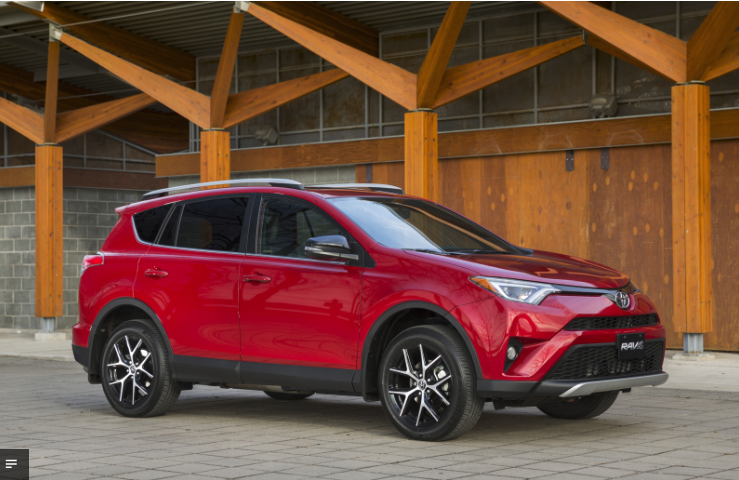First Drive: 2016 Toyota RAV4 & RAV4 Hybrid

Story and photo by John LeBlanc
GATINEAU, Que. – Everybody wants to buy a crossover these days, and everybody wants to save a bit of money at the pumps. So, who wouldn’t want to buy a crossover hybrid? At least, that’s the assumption Toyota is making with its new 2016 RAV4 Hybrid. First seen at last spring’s New York Auto Show, over six months later the refreshed-for-2016 RAV4 compact crossover family is being rolled out by Toyota.
While the gas-only RAV4 lineup of front- or all-wheel-drive, five-passenger crossovers gets the typical exterior, interior and engineering midlife upgrades (mainly to keep up with mainstream rivals like the Honda CR-V and heavily updated 2017 Ford Escape), the big news is the addition of the RAV4 Hybrid, a new model that immediately becomes the most fuel-efficient non-plug-in compact crossover you can buy.
While Toyota has tried to pitch its Prius V as a hybrid crossover, the tall wagon’s lack of traction at all four wheels and unconventional styling has kept its sales limited. And after flirting with low-volume, all-electric versions of the RAV4 between 1997–2003 and 2012–2014 in the U.S., a more practical and accessible hybrid version based on proven Toyota hardware makes a lot of sense.
In truth, the new all-wheel-drive 2016 Toyota RAV4 Hybrid (initially available as high-end $34,465 XLE and $38,265 Limited versions, base MSRP) has already been on sale since last year. You may know it as the $59,450 Lexus NX 300h AWD, which shares the Toyota’s platform and Atkinson-cycle 2.5-litre gas-four with a second rear-mounted axle motor for traction at all four wheels, and a continuously variable automatic transmission.
Rated at 194 horsepower and 206 lb.-ft. of torque, the new 2016 RAV4 Hybrid offers a substantial upgrade over the non-hybrid RAV4’s carryover 176 horses and 172 lb.-ft. 2.5-litre gas mill’s numbers. As such, at around 7.5 seconds, the RAV4 Hybrid is about one second quicker from zero to 100 km/h than a comparable gas model and – more importantly – gets better fuel economy, too.
The RAV4 Hybrid is expected to score 6.9 L/100 km in the city and 7.2 on the highway. I had less than an hour of seat time during the one-day driving event held on the Quebec side of the Ottawa River, in Gatineau; however, in a mix of city and suburban traffic, I saw an indicated 6.8 L/100 km. I’m sure some hypermilers out there can do better, but that’s still an improvement over the most fuel-efficient gas-only RAV4’s 8.9 L/100 km combined estimate.
As for the rest of the new RAV4 Hybrid’s driving experience, there are few surprises. Because Toyota’s been at this hybrid thing since the mid-1990s, the refinement levels of its gas-electric systems are second to none – which means the transition from electric to gas and back in the RAV4 Hybrid is virtually unnoticeable, and the crossover’s regenerative brakes are less grabby than in hybrid vehicles from other automakers (hello, BMW).
Like the Lexus NX 300h, the RAV4 Hybrid gets selectable drive modes. I found small dash buttons for Normal, Sport, Eco and EV modes, but the real-world differences are minor. In EV mode, you won’t drive far in the Toyota hybrid crossover on electric power alone (I only saw a few metres after accelerating from a stoplight). Sport mode won’t have you booking a trip to a racetrack, as the RAV4 Hybrid’s suspension has been tuned for comfort first, resulting in plenty of body movement in tight corners. And steering feel is about as limp as a day-old trout.
That said, the interior upgrades the entire RAV4 family receives makes all the 2016 models feel more upscale than ever. The RAV4’s driver instrumentation has been updated, including a larger touchscreen infotainment system and a surround-view parking-assistance feature. Plus, there is more use of soft-touch materials, available two-tone interiors and more noise insulation, among other additions and refinements.
Of the non-hybrid 2016 RAV4s available at the event, I got behind the wheel of the new-for-2016 RAV4 SE AWD trim level. At $34,620, the sportiest RAV4 you can buy sits nearer the top-of-the-line $37,500 Limited AWD rather than the base-model front-wheel-drive $24,990 LE. To distinguish it among lesser versions, the RAV4 SE gets some typical sporty bits, including black exterior accents and black-painted 18-inch wheels, a mesh grille and trendy LED exterior lights. Inside, SE exclusives include paddle shifters for the transmission and so-called Softex seat upholstery with unique stitching.
Toyota says the SE also gets a “sport-tuned” suspension, yet the sportiest of RAV4s will not get the hearts of driving enthusiasts pounding too hard. The Toyota’s vanilla driving characteristics are closer to the Honda CR-V than some of the more athletic rivals, like the Ford Escape or Mazda CX-5. The steering on the Toyota gives little feedback and the suspension crashed over the potholed Quebec roads I briefly navigated.
Other than the abovementioned changes, the updated 2016 Toyota RAV4 remains the roomy and easy-to-live-with compact crossover that has made it one of the most popular new vehicles in Canada.
In the end, the new 2016 midlife upgrades should keep the Toyota compact crossover near the top of the sales charts – plus, the availability of the new RAV4 Hybrid not only offers best-in-class fuel economy ratings but can also be viewed as a real alternative to the pricier Lexus version.





![[del.icio.us]](https://www.straight-six.com/wp-content/plugins/bookmarkify/delicious.png)
![[Digg]](https://www.straight-six.com/wp-content/plugins/bookmarkify/digg.png)
![[Facebook]](https://www.straight-six.com/wp-content/plugins/bookmarkify/facebook.png)
![[Google]](https://www.straight-six.com/wp-content/plugins/bookmarkify/google.png)
![[Reddit]](https://www.straight-six.com/wp-content/plugins/bookmarkify/reddit.png)
![[StumbleUpon]](https://www.straight-six.com/wp-content/plugins/bookmarkify/stumbleupon.png)
![[Twitter]](https://www.straight-six.com/wp-content/plugins/bookmarkify/twitter.png)
![[Email]](https://www.straight-six.com/wp-content/plugins/bookmarkify/email.png)